Farewell to the 13th Earl of Airlie, the last grand royal courtier from The Greatest Generation
It makes me smile when I recall that his wife Ginnie called him "Dave"
One fascinating aspect of writing about the British royal family is getting to know men and women in the royal household. The courtiers are the salaried high-level advisers around the monarch and consort. The ladies-in-waiting have typically been aristocratic friends of the Queen or Queen Consort, who receive minimal stipends to cover their expenses. Now called Queen’s Companions by Camilla, they have customarily provided assistance on royal engagements and help with correspondence.
This past week marked the death at 97 of one of the late Queen Elizabeth II’s closest counselors as well as a lifelong friend: David Ogilvy, the 13th Earl of Airlie. He is survived by his 90-year-old American wife, Virginia, the Dowager Countess of Airlie, who served for more than fifty years as a lady-in-waiting to the Queen. In modern parlance, they might have been called the ultimate power couple, just a notch down the hierarchy from the Queen herself.
David Airlie (as he was known after succeeding to the earldom in 1968 on his father’s death) achieved great success as a merchant banker at Henry Schroder & Co for more than thirty years, and a modernizer for Queen Elizabeth II as her Lord Chamberlain—the chief executive of her royal household from 1984 to 1997. He carried out extensive reforms to streamline the Queen’s staff and operations, to establish long-term funding for official royal activities, and to open Buckingham Palace to tourists for the first time. He also persuaded the Queen to pay income tax, and after a devastating fire at Windsor Castle in November 1992, he devised a plan to finance the restoration without using public funding. Perhaps most memorably, in September 1997 he managed the funeral arrangements for Diana, Princess of Wales after her tragic death in a car crash in Paris at age 36. As there were no plans in place, he had to organize it “de novo.”
Lord Airlie was born in Scotland less than a month after Queen Elizabeth II. Although he had been in declining health, he attended the coronation of King Charles III in May, where he was seated in the front row of the nave at Westminster Abbey. He was the only guest who also attended the 1937 coronation of Charles’s grandparents, King George VI and Queen Elizabeth. At age ten, he had served as a page for his father, the 12th Earl, carrying his coronet.
I got to know David Airlie and his wife Ginnie—the correct spelling of her nickname, not the often-used “Ginny,” as I learned from the earl himself—when I was working on Elizabeth The Queen: The Life of a Modern Monarch. At the time, Ginnie was one of the Queen’s most senior ladies-in-waiting. They both gave me an invaluable perspective on the Queen, Prince Philip, and their eldest son, now King Charles. I would like to share some personal impressions from my encounters with them starting in 2009. We had a number of mutual friends, and I had known his younger brother, Jamie Ogilvy, since the late 1990s: a friendship that helped open the door to the earl and countess.
As a couple, they were exceptionally charming in different ways. At age 26, David had married Ginnie in October 1952 at St. Margaret’s Westminster in London, where Queen Elizabeth the Queen Mother and Princess Margaret were among the guests. The 19-year-old bride was Virginia Fortune Ryan, a wealthy American born in Newport, Rhode Island. Her parents were John Barry and Nin Ryan, popular figures in Manhattan and Newport high society.
I first spent several hours with the Airlies in their spacious flat near Lower Sloane Street in London. Ginnie’s sitting room at the back of the apartment had high ceilings, walls painted apple green, shelves filled with books, and pretty paintings. A desk between the windows was piled high with papers—“more messy” than her husband’s, she confessed. His sitting room at the front of the flat was similarly elegant, and as Ginnie predicted, with not a paper out of place.
At age 76, the countess was petite and animated, down-to-earth, and no-nonsense. She wore her short gray hair simply styled, and she had an appealing sense of humor. The photographer Cecil Beaton called her “a paragon of gaiety and dignity. She never does anything wrong but shows great independence of attitude.” Her friend Lady Annabel Goldsmith told me “She doesn’t bother with Botox or facelifts. She is lively and fun. She must be fun for the Queen.”
Ginnie’s 82-year-old husband was tall and debonair, silver-haired and still handsome. “He is very buttoned up, and you should see him separately,” his brother Jamie advised me. “You will get a very good slant. He has known the Queen for many years. He will be up front, not defensive.” As reserved as his wife was outgoing, he nevertheless spoke expansively about the work he had done for the Queen and astutely explained her decision-making process. Although he had been out of royal service for 12 years, he still had his finger on the Palace pulse. Both he and his wife offered me insights on the private side of the royal family as well.
His first memory of the Queen was his fifth birthday. He celebrated it at Cortachy Castle, his family’s Scottish estate near Glamis Castle, where Queen Elizabeth the Queen Mother had grown up. “See that photo over there of me with my pedal car,” he said, pointing across the sitting room.
“I had a tea party for my birthday, and the two princesses [Elizabeth and her younger sister Margaret] were invited from Glamis. My father and mother had given me a pedal car, and my father said, `You should let Princess Elizabeth ride in it.’ I said, `No way.’ That was that. We had quite a row, and I lost. The picture is of her in my pedal car and me pushing it with a furious face.”
He remembered when the Queen had a big reception during her Golden Jubilee celebrating fifty years on the throne in 2002, “I had to make a speech in front of hundreds of people,” he said. “I told that story. The Queen looked at me, and I turned to her and said, `If I’d known you would one day be Queen, and I would be your Lord Chamberlain, I would have chosen my words more carefully.’”
Starting in the early years of the Queen’s reign, he and Ginnie were asked to the monarch’s estates at Sandringham in Norfolk and Balmoral in Scotland for shooting weekends. When the Queen inquired in 1973 if Ginnie would be interested in becoming one of her ladies-in-waiting, Ginnie was “amazed.” “I said, `You realize I am still an American subject, and David is a banker, and I have six children,” she recalled. “Perhaps you should get someone more steeped in it all. She said, `No, no, I would like you to do it.’” Lady Airlie signed on and served until the Queen’s death.
In 1984, David Airlie entered royal service in a similarly informal way. “I don’t really know how I got the job,” he told me. “It was well known I was going to retire from Schroders. If the Queen did not know someone well, she would rely on her advisers. She knew me warts and all. There was no interview.” The retiring Lord Chamberlain, Lord “Chips” Maclean, had been friendly with David Airlie since they served together in the Scots Guards during World War II, so he was deputed to gauge the earl’s interest. Soon afterward, the Airlies were at Sandringham for a pheasant shoot when the Queen took David aside and asked, “Do you really want to be Lord Chamberlain?”
“It was off-the-cuff, which was typical,” he recalled. “It was thought-through, but she has a light touch.” The day after he left Schroders, he walked into Buckingham Palace and saw his friend since childhood through a professional lens for the first time. He was instantly impressed that she was “very business-like, very correct. You wrote her a memo, and it came back very quickly. If she didn’t like it, it didn’t come back, and you knew things were not working out well.”
When Lord Airlie was first appointed to the royal household, Ginnie said to the Queen, “I ought to go. You don’t want too many Airlies around. The Queen said, `Don’t be silly. It won’t be a problem.’” Ginnie kept her husband’s dealings with the Queen at arms’ length. “He and I hardly ever met,” she recalled. “I kept away except when I was on duty.” While David stayed at the Palace, Ginnie accompanied the Queen on trips overseas and around England.
Ginnie only offered one tip to her husband about a particular feature of his new job: the ritual of walking backward in the Queen’s presence at banquets and other official functions. “I used to say to him, `Find a pattern in the carpet and stick to it.’ I was always afraid he would fall over.” He took her advice, with one additional precaution: “I knew I mustn’t drink too much.”
When he made 188 recommendations for changes at Buckingham Palace, the Queen gave the green light to 160 of them. Throughout the modernizing process, Prince Philip “was very important. I brought him along at all stages. He was sharp as a razor at asking questions. He always came from a different angle you hadn’t thought through yourself.”
On reading the Lord Chamberlain’s final report, the Queen supposedly remarked, “Why have I got so many footmen?” David Airlie didn’t recall hearing that comment but added that “it would be typical. She knew perfectly well how many footmen she had. It was a throwaway line.”
Over the years since our initial conversations, I kept in touch with the Airlies. In November 2013 Ginnie and I ended up on the same flight to Washington, DC from London. At age 80, she had just finished a round of duty with the Queen for the Korean state visit, and she was going to visit a nonagenarian friend in Virginia. She was carrying her mother’s battered T. Anthony bag dating from the 1940s with a pale blue “Queen’s Flight” tag saying, “Wanted on Aircraft.” And she was flying economy.
She was in top form, sharing amusing observations about the recent Diplomatic Reception at Buckingham Palace. One diplomat had brought his yoga teacher as his guest. “She offered me her advice against jet lag and in general,” Ginnie said. “Every morning when you wake up you should put your feet against the wall above your head, legs straight out, to get the circulation going. I have done it for several days and it has helped my back problems. I will tell Dave about it.”
It was the first time I had heard her call the 13th Earl “Dave,” and I couldn’t help smiling. She explained that at age 87, he had injured his ankle while walking in the snow in Scotland. Ginnie had been on duty with the Queen, and he had been hospitalized in Dundee where he was bossed around by a “rather large nurse.” Back at home, he was “walking with a stick and doing well.”
She also reported that they now had 14 grandchildren and were soon to meet their third great-grandchild. Five years later, I called her to describe an evening in the Bahamas with one of her longtime friends on her 85th birthday. “I’m feeling rather old,” Ginnie admitted. “It’s my 85th birthday today.” But she was anything but downhearted: “The grandchildren and great-grandchildren have been calling me all day.”

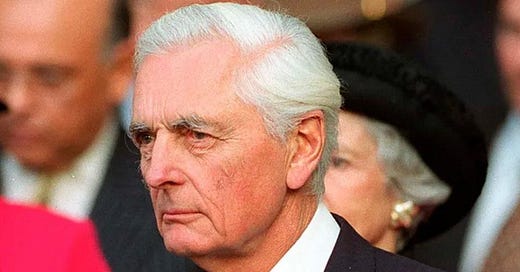



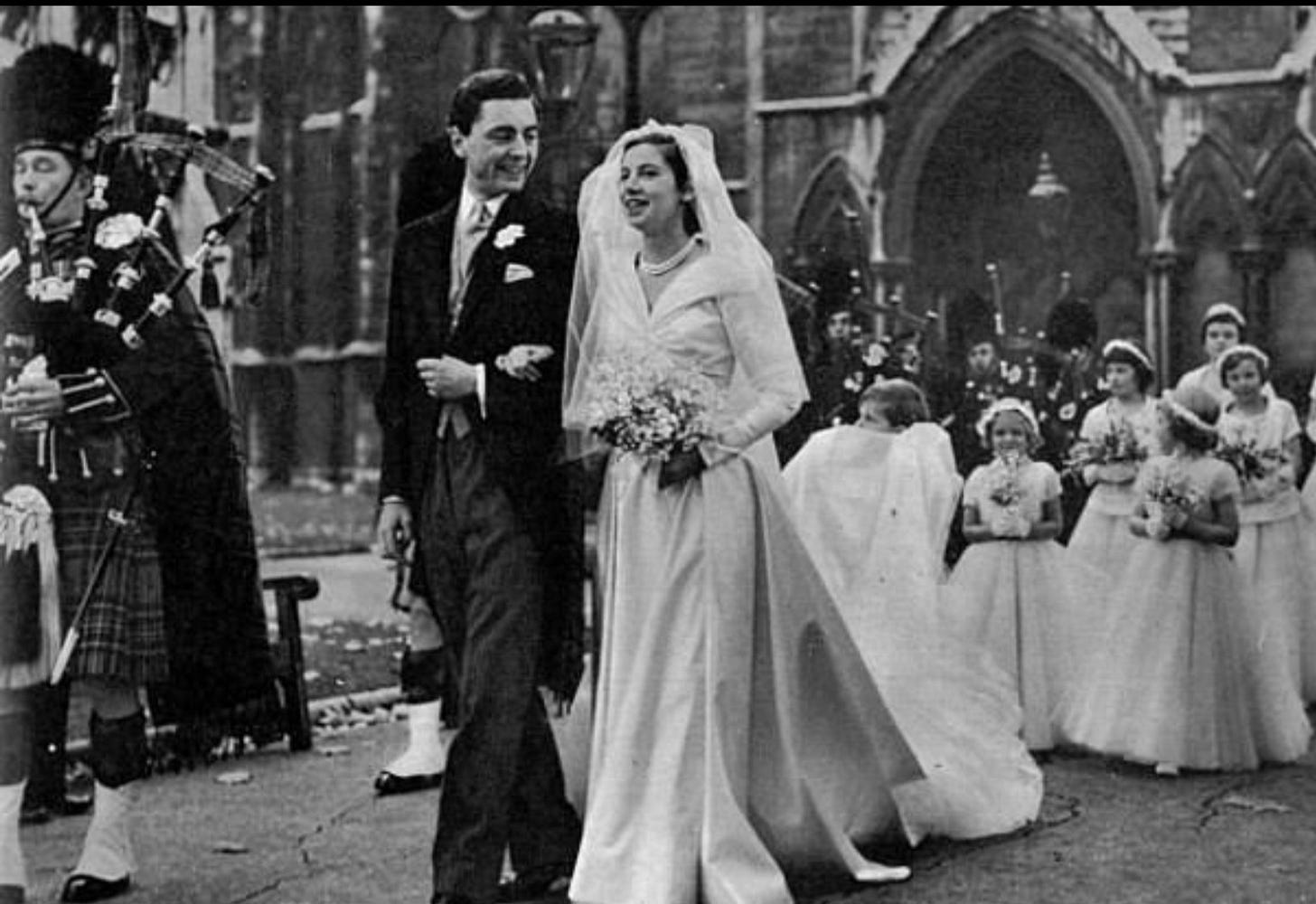
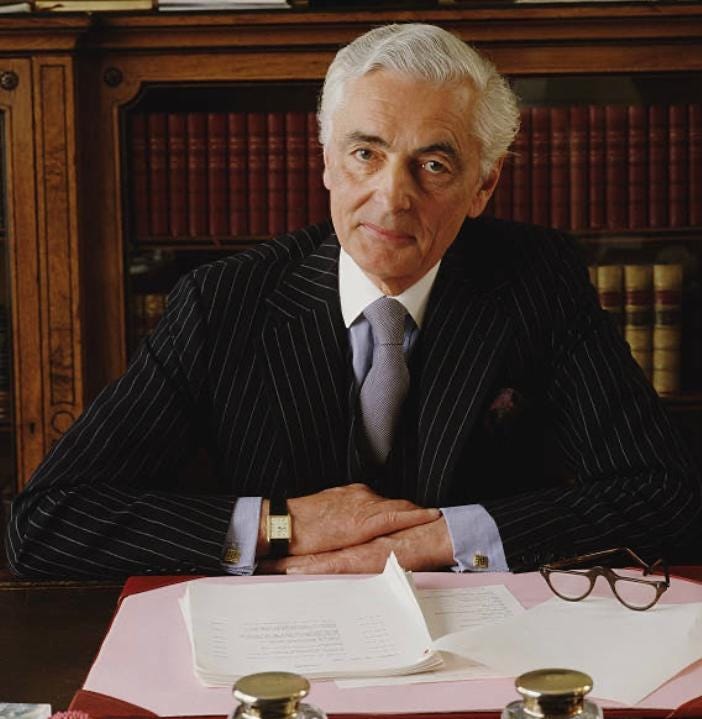
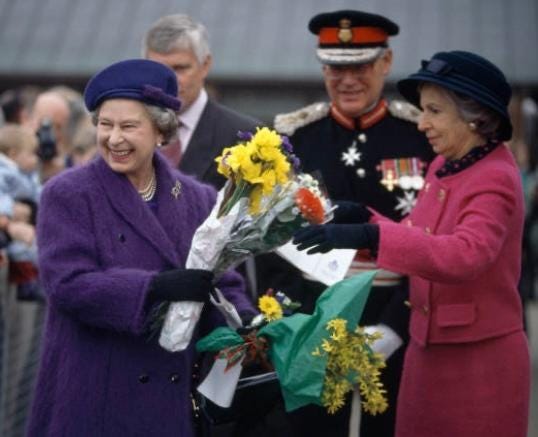
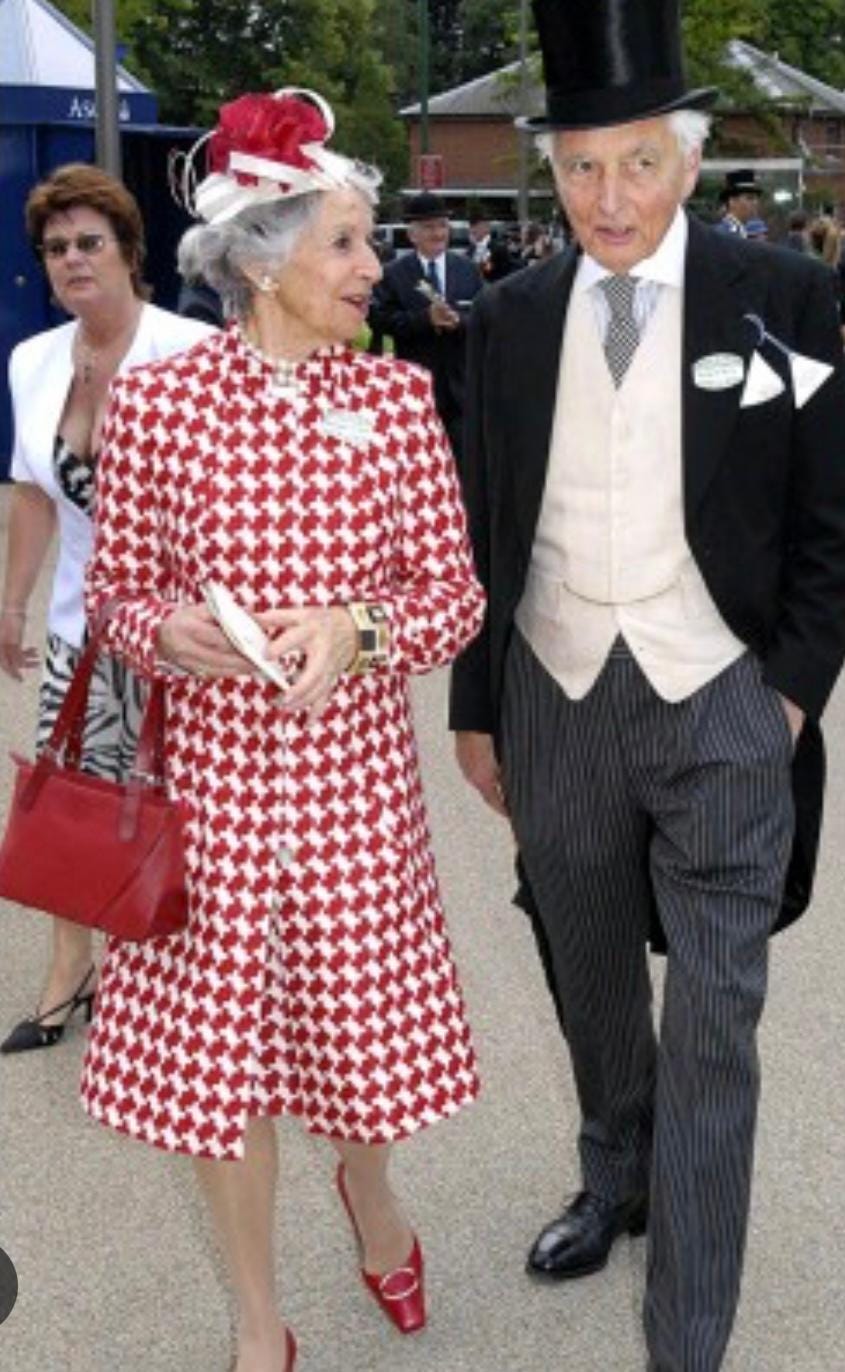
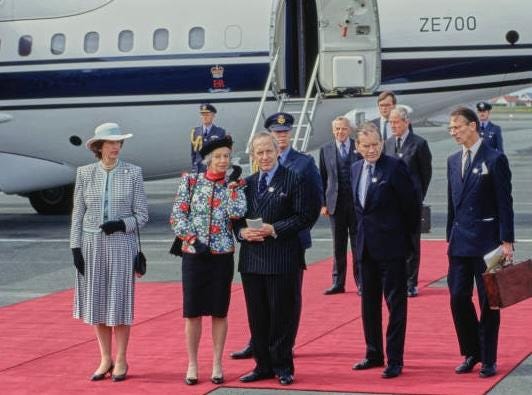
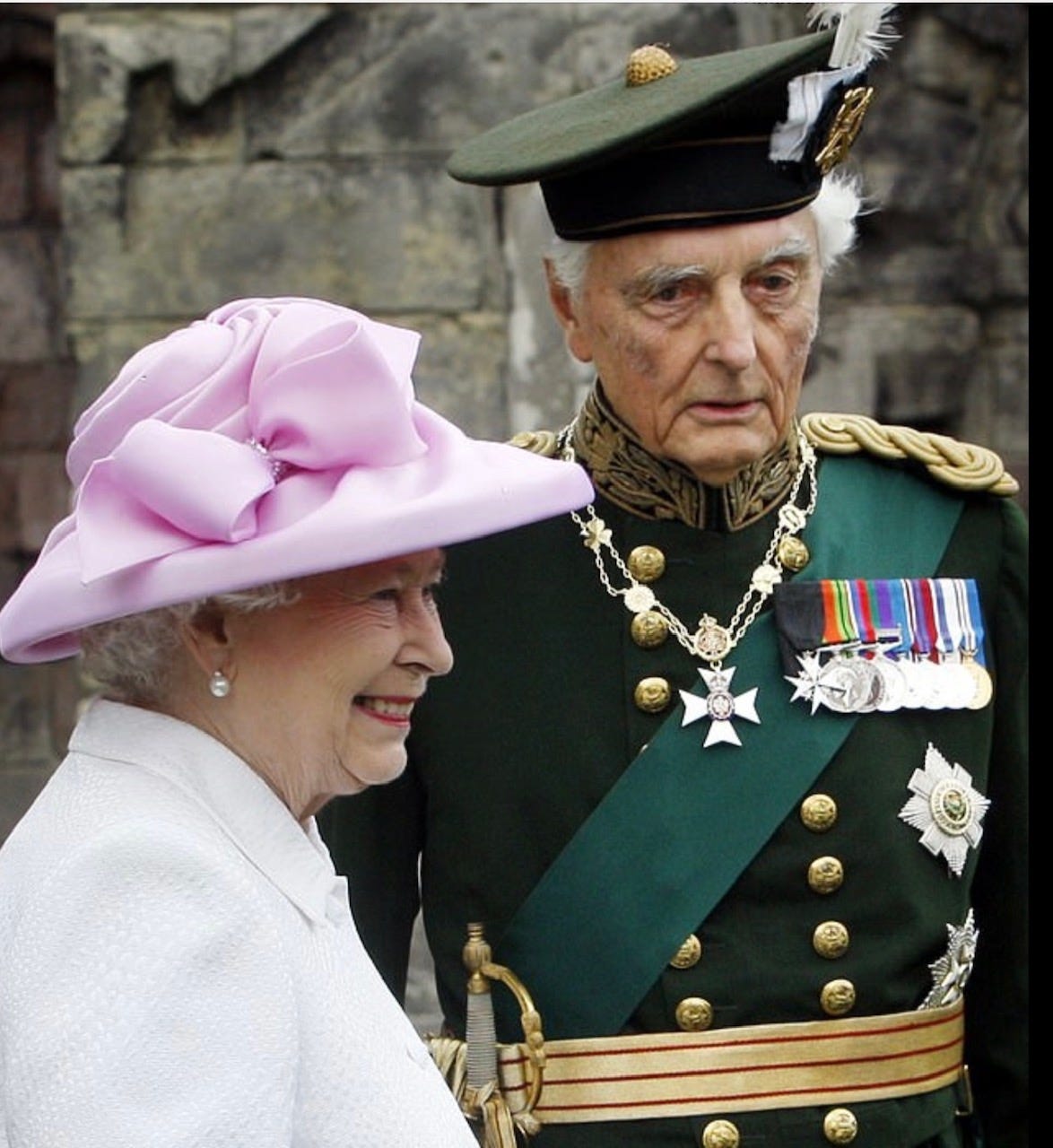
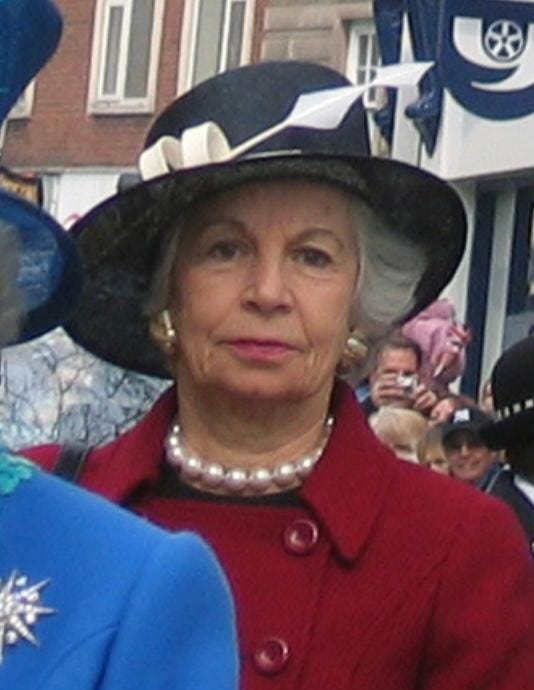
Hi Sally- this is a wonderful description of devoted friends to Her Majesty. A rare couple!! Bravo.
Appreciate the access to more insight on the Airlies.....a great post. Successful relationships have a positive effect on everyone in their orbit!